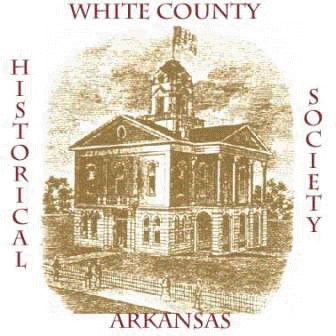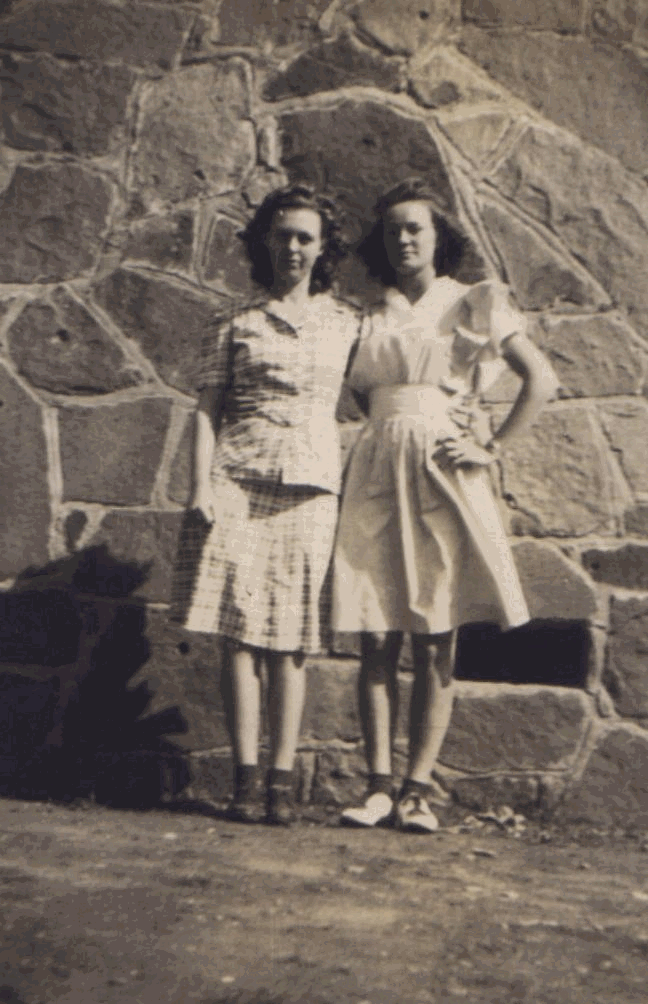

Mount Pisgah

School at Mt. Pisgah -
Lola Whitten Hughes & Johnnie Parks Lowery – 1943
--photo courtesy Diann Poe, WCHS
MOUNT PISGAH – The pioneers who settled Mount Pisgah, starting about 1816, called their new home "Mount Pisgy." That’s what it’s still called by the approximately 100 residents who live in the White County farming community about three miles south of Letona.
The early settlers got the name from the Old Testament, where it refers to a mountain east of the Jordan River. The Israelites came to it on their way to the Promised Land and Moses, who wasn’t allowed to go all the way, climbed Pisgah to look at the Promised Land before he died.
Thomas Haney, whose great-grandfather came to the area in about 1855, believes settlers were attracted by cheap land ("25 cents an acres") and easy access to water. "There were springs and creeks in the area," he said.
Early settlers came from North Carolina and Alabama and, a little later, from Illinois. The Magness family may have been the first to arrive, Haney said. Magness Creek bears their name.
When her husband had to be away, Mrs. Magness put on men’s clothes to fool the Indians in the area. Men took their guns to church in those early days to protect themselves and their families from attacks by Indians who camped near the foot of the mountain.
If you visit the large Mount Pisgah cemetery, you’ll find tombstones of people born in the 1820s. Haney believes people were buried there as early as 1830. He’s heard that Indians used the same burial ground before the settlers arrived.
Haney’s grandfather, Jimmy D. Haney, was just a boy during the Civil War but he found himself close to a small battle. According to Mrs. W.C. Welch, writing in the June 1965 White County Heritage, Jimmy D. and a playmate were hiding a horse in the woods when a Confederate captain and a group of men attacked some Yankee soldiers who were camped near the mountain. The captain and his men were soon fleeing through the woods, but they paused long enough to take the boys’ horse to replace one of theirs that was exhausted.
Thomas Haney said that he has found Civil War Minie balls on his farm. He’s also found arrowheads there.
Welch wrote that Mount Pisgah was a thriving village at the turn of the century. Early general stores were operated near the cemetery by a Mr. Kates, Jim Gray and J.R. Woodson. Woodson was the first postmaster and the post office was in his store. Thomas Haney thinks the post office probably lasted from about 1880 to about 1910.
Welch said a Dr. Ward practiced medicine and had a drugstore as well as an office in Mount Pisgah. Amos and Charlie Suit had a store where caskets were sold. Welch wrote, "The Suits were also photographers and they ran a picture studio adjacent to the casket shop."
The older citizens mentioned to her that an effort was made to open a saloon in the village before 1900, but public opinion prevailed against it.
The early churches at Mount Pisgah included Methodists, Presbyterians and Baptists. The Methodist and Baptist buildings are apparently still in their original locations near the cemetery.
The first school had a one-room building in the cemetery. Later buildings were about a half-mile south. After Mount Pisgah lost its school to consolidation in 1947, the building was converted into a home by Claud Smith.
The village’s shift to the south and a little east came after the Missouri and North Arkansas (M&NA) railroad began providing service to Mount Pisgah in 1906. There was no depot, but there was a flag station in the new part of town. Welch said that you flagged the train with a white handkerchief by day and a swinging lantern by night.
Stores and houses were built near the flag station. Paul Crain, whose father, Jake, ran one of the stores, said that people joked back then that M&NA meant "May Never Arrive."
Crain said his father had to close that store in 1930 because a drought and the Depression were forcing people to buy on credit. "My father didn’t have money to buy things to sell with," he said.
Another nearby store was owned by a Mr. Kincaid. Crain said that when he was 7 or 8, he was Kincaid’s partner in croquet games.
Paul Crain later played basketball for the Mount Pisgah School. Evidently the rivalry with Crosby, about three miles south, was intense. Crain remembers his school borrowing a player from Letona for a game against Crosby. In those days, the courts were outside, he said.
Elton English, who grew up in the Georgia Ridge community on top of the mountain, lived close enough to Mount Pisgah to do farm work there. He said that around 1939 and ’40, he would come through a low gap in the mountain to plow cotton for the Crozier family.
Besides cotton, he remembers farmers raising corn for their livestock, sorghum for molasses, strawberries and peanuts. Now they’re more likely to have cattle or tree farms.
English said that when electricity came to the area, Earl Willingham would not let the power company top his trees. The result was – and still is – some of the tallest poles for electric lines you’ll see anywhere.
English said that when the Depression hit, his father hunted in the winter to supplement his income. He bought a young hound named "Eagle" and worked at hunting like men work at a job. "He made $200 during hunting season," English said. "Once, he got a $5 bonus for a gray fox fur."
Elton English and his family eventually moved to Mount Pisgah. They took care of John Victor Nations for a few years before his death in 1967.
John Victor was an orphan in the 1890s; when he was adopted in Clarksville he didn’t know his last name, age or where he had come from. According to Mrs. Leister Presley of Searcy, he knew that his two brothers and baby sister had found homes with relatives but no one took him. He also knew he had come a long way by train.
His new parents moved to White County, where the father, David Nations, died in 1913. John Victor never married, but lived with his mother until she died. He lived alone, but had many friends and loved to be with them. When he had no one else to talk to, he would go out to the road in front of the house and talk to people as they passed by, Presley said. When the English family came, he not only had someone to talk to, but he also had Elton English to hunt with.
One thing that a visitor in Mount Pisgah notices is the gravel roads where there would be paved streets if the village had continued to grow. But the most noticeable thing, and the biggest, is the mountain.
Speaking of the old part of Mount Pisgah, where the cemetery and churches are and where the first stores used to be, Welch wrote: "In that picturesque setting and near the resting place of their loved ones … the entire scene is guarded over by Mount Pisgah, the mountain, as it stands like a sentinel through the ages."